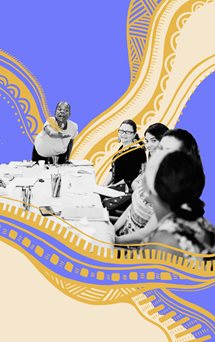MUSE ARTS (a.k.a Sick Muse Art Projects) works to increase support, access and visibility to immigrant, refugee and newcomer artists and their communities. They develop community art programs that integrate arts and social justice, including HAPPENING Multicultural, the annual Multi-Arts Festival, the creation of community murals, and their international Community Arts Residence and Cultural Exchange Program.
MUSE ARTS Program Director Paola Gomez shed some light on MUSE, their values and how it feels to be a 2020 finalist.
 Artwork by Amber Williams-King
Artwork by Amber Williams-King
What was the inspiration to start MUSE ARTS?
MUSE is the manifestation of our creative spirits, our strong sense of community, which is born from surviving through Arts, the violence we grew up with and that we were lucky to escape, and our cry for justice. Muse Arts to us is our daily acts of radical generosity, social and civic responsibility. We know firsthand that a creative person can overcome adversity. We know that we need to use our place of influence to continue promoting and creating spaces for all to live with dignity, and with possibility of reaching their full potential. MUSE is an act of hope.
A big part of MUSE is the idea of social justice and social change. How do you integrate this into your programs?
Social Justice is at the foundation of why we got together to do this. All our programs come from a place of recognizing the injustice, displacement and violence that has impacted and continues to impact our communities. We believe in the transformative power of the arts and creativity, and are determined to create platforms to amplify voices and engage communities, particularly those who have experienced displacement, holding conversations of accountability and transformation without forgetting our healing process and humanity.
You have created and produced the HAPPENING Multicultural Festival for multiple years. Why is this an important part of MUSE ARTS’ activities?
We support, develop and promote the work created and interpreted by immigrant, refugee and newcomer artists. In 2016 when we created the Festival, we wanted to change the anti-immigrant and anti-refugee narrative that is reinforced by the assumption that refugee and newcomers, in our case, artists and creators, are ONLY recipients of services or/and culture. We wanted to send a message. We wanted to say to our communities: “We are here. We are also creators, givers, producers and promoters. We arrive with knowledge and long carriers. We are taking space and creating a platform to embrace our work and celebrate it, not because we are seeking approval or validation of who we are, but because of our contributions, we also build our communities. And we are your neighbours.” This is at the core of who we are and why we exist.
During 2020, you created the Doves of Peace project to help inspire people to create art from a distance. What has been the response from the community?
The Doves of Peace Project has been part of our way to connect all our initiatives and communities. We have been very interested in exploring community members’ interpretation of peace and their views on how one achieves it. The Doves of Peace was going to be a strong component of our planned HAPPENING Multicultural 2020, but once COVID-19 forced us to re-think the way in which we would move forward with the Festival, we felt that it was very important to bring the Doves of Peace, not only to explore the concept of Peace, but also “Community”. We immediately created to ways of engagement with this initiative: a) Online, where community members could download our template and respond to the statements proposed, and b) mail-art, where we would send interested community members a canvas of the shape of a dove with a self-address envelope, and the community member would intervene the dove and send it back to us. We did not imagine that we were going to have such a response. Our online version has been shared across Canada, has travelled to USA, some countries in Latin America and we have received #dovesofpeace photos from Kenia and Egypt. Our mail-art component has travelled the GTA, and other cities in Ontario. To our surprise, we started receiving mail-art from USA. At this moment we have 200+ doves which have been intervened and returned to us. We have distributed over 400. We are hoping to distribute 300 more, as we are involving kids from the refugee and homeless shelters in the program; we have included canvas of the shape of a dove in the Creativity Kits we distribute to shelters, along with a video-explanation of the #doveofpeace.
How does it feel to be nominated for the Community Arts Award?
This is an immense honour. We do this work with so much love and care, always being respectful of our communities and our partners. Sometimes, due to the nature of the work and the communities with work with, it feels that it is very silent. We don’t complain about that, we know it is how it should be. We admit it is extremely humbling to know that our peers see us and that they acknowledge what we do and the reason and importance of doing it. We are grateful to our team, all very talented immigrant, newcomer and refugee artists, who also believe in the transformative power of the arts. Above all, we feel grateful to our partners and communities of participants for their trust, their willingness to work with us and their openness to welcome us into their spaces so we all can learn and dream together.